
Snow and Ice Control
17
tions should always be conducted during the storm. Ideally, plowing should
commence before snow depth reaches four inches to permit the greatest effi-
ciency and effectiveness. Most installations and municipalities in CONUS begin
snowplowing when the snow reaches three inches, and continue around the clock
until the storm is over and the roads are bare.
Figure 8. HMMWV snowplow mounted on a HMMWV with chains on all four
wheels. This snowplow can be mounted and dismounted in less than a
minute after the on-vehicle frame push-plates and the wiring harness are
installed.
The 9-foot by 29-inch, 11-gauge steel, trip-edge snowplow was initially
purchased with a continuous curve snow foil and a 1090 high-carbon steel
cutting edge. The pump, hydraulics, headlight, directional lights, and attaching
A-frame hardware are integral to the plow, as are the trip-edge and the trip-edge
springs. This heavy-duty snowplow is commonly used on commercial light,
medium, and heavy-duty series pickup trucks and light trucks up to two tons.
The plow has a fully reversible angle capability of 28 degrees to the right and
left; and it has up (10 inches) and down capability, all of which can be controlled
from the driver's position in the cab. The plow also has an integral trip-edge that
folds back and allows the plow to ride over obstacles up to four inches high.
When the obstacle is cleared, spring tension is released so that the cutting edge
returns to its normal plowing position.
During testing of the snowplow in various scenarios, 450 pounds were
loaded into the back of the HMMWV; however, no significant advantage was



 Previous Page
Previous Page
